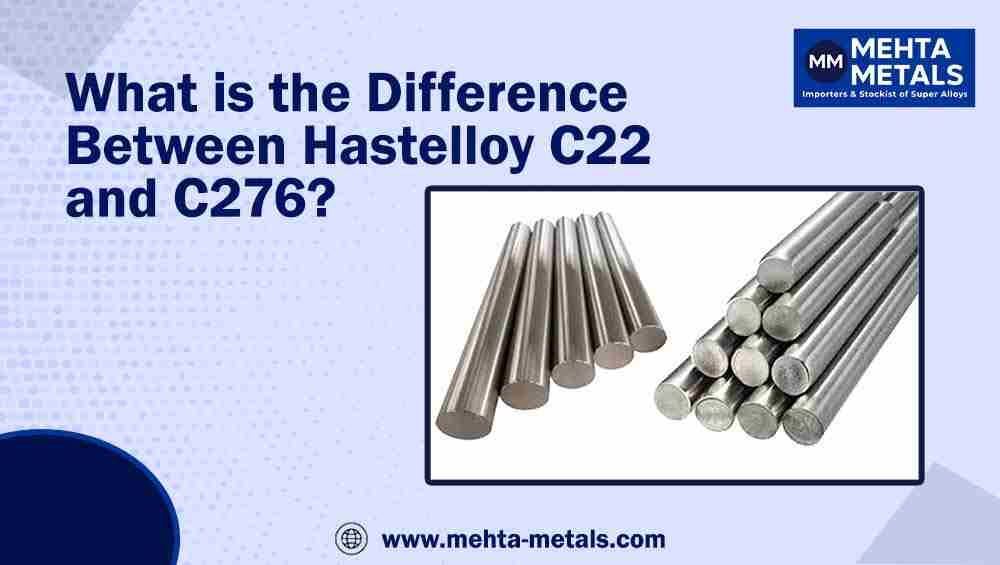In the world of steel, superior corrosion-resistant alloys are needed, and Hastelloy C22 and Hastelloy C276 are among the most reliable names within it. These nickel-based superalloys are widely used due to their superior resistance to harsh environments.
At Mehta Metals, we are the most crucial exporter and supplier of Hastelloy alloys under ISO and international standards, but one question is being frequently asked to us by many experts: What is the difference between C22 and C276?
This weblog breaks it all down — from C22 vs C276 chemical composition to program variations — so you ought to make the best material need on your desires.
What is C22? Understanding Alloy C22
Alloy C22, sometimes also called Hastelloy C22, is versatile in nature because it is made up of nickel-chromium-molybdenum-tungsten alloy. It’s specifically engineered to offer notable resistance to an enormous range of corrosive media, every oxidizing and lowering.
Key Features of Hastelloy C22:
- Excellent resistance to crevice corrosion and pitting
- Superior universal overall performance in oxidizing environments like nitric acid and ferric salts
- Outstanding versatility across chemical processing, prescribed drugs, and waste treatment
This alloy is specifically effective at the same time as coping with environments in which corrosion situations change or multiple agents are gifted.
What is C276?
Alloy, which is known for its consistent performance in demands, generally in competitive settings, is Hastelloy C276. It performs better overall in decreasing conditions because it contains more tungsten and molybdenum.
Key Features of Hastelloy C276:
- Exceptional resistance to sturdy lowering dealers
- Suitable for sulfuric, hydrochloric, and phosphoric acid situations
- Great for chemical reactors, pulp and paper bleaching systems, and flue fuel scrubbers
C276 is regularly the primary preference for chemical system industries with extreme-temperature and high-stress exposure.
C276 vs C22: What’s the Real Difference?
Though C22 and C276 belong to the same Hastelloy family, they vary in key components. Let’s break down the difference between C22 and C276 with a focus on chemical composition, corrosion resistance, and prices.
-
Hastelloy C22 vs C276 Chemical Composition
| Element | C22 (%) | C276 (%) |
| Nickel | 56 min | Balance |
| Chromium | 20–22.5 | 14.5–16.5 |
| Molybdenum | 12.5–14.5 | 15–17 |
| Iron | 2–6 | 4–7 |
| Tungsten | 2.5–3.5 | 3–4.5 |
| Cobalt | 2.5 max | 2.5 max |
The higher chromium content in C22 makes it better for oxidizing conditions; at the same time, C276’s greater molybdenum and tungsten content material cloth offer it a huge gain in lowering environments.
-
Corrosion Resistance: Alloy C22 vs C276
- C22: Performs better in oxidizing chemical substances together with nitric acid, ferric salts, and chlorine-bearing media. It’s also higher at resisting pitting and crevice corrosion.
- C276: Excels in decreasing environments like hydrochloric acid, sulfuric acid, and organic acids. It has better resistance to stress corrosion cracking.
-
Weldability and Fabrication
Both alloys offer top weldability, but C276 is slightly less tough to weld and fabricate due to its lower chromium content. For complicated issues in manufacturing or applications where large welding is needed, C276 may be the preferred choice.
-
Typical Applications
C22 is ideal for:
- Flue gas scrubbers
- Waste remedy structures
- Chemical blending tanks
- Pharmaceutical reactors
C276 is usually used in:
- Heat exchangers
- Marine exhaust systems
- Pulp and paper digesters
- Chemical method vessels and piping
What Should You Choose? C22 vs C276
Choosing between C22 and C276 is predicated upon your specific applications and running surroundings.
- Go with C22 in case you’re operating in mixed or converting chemical conditions with oxidizing sellers.
- Opt for C276 if your setup includes strong acids, extreme strain, or lowering sellers.
We do not accept a one-size-fits-all response as true. We offer free sessions to help clients pick out the most suitable alloy based on corrosion type, temperature, and application.
Why Mehta Metals?
- We’re the most important provider and exporter of Hastelloy alloys, which include C276 and C22, depending on the course of industries international.
- Our products follow ISO and international requirements.
- We offer short delivery, custom orders, and professional technical steering for every consumer.
- Our client-first method guarantees you get the proper material for the right cause.
Conclusion: Making the Right Choice Between C276 and C22
Understanding the difference between C22 and C276 will save your equipment from failure, lessen protection prices, and decorate safety in your operations. Whether you’re managing corrosive chemical substances or extreme-temperature environments, choosing the first-rate alloy is crucial.
At Mehta Metals, we’re proud to be your depended-on companion, imparting exceptional substances and expert help. Still uncertain whether or not to choose Hastelloy C22 vs C276? Contact us in recent times, and we’ll guide you every step of the way.

